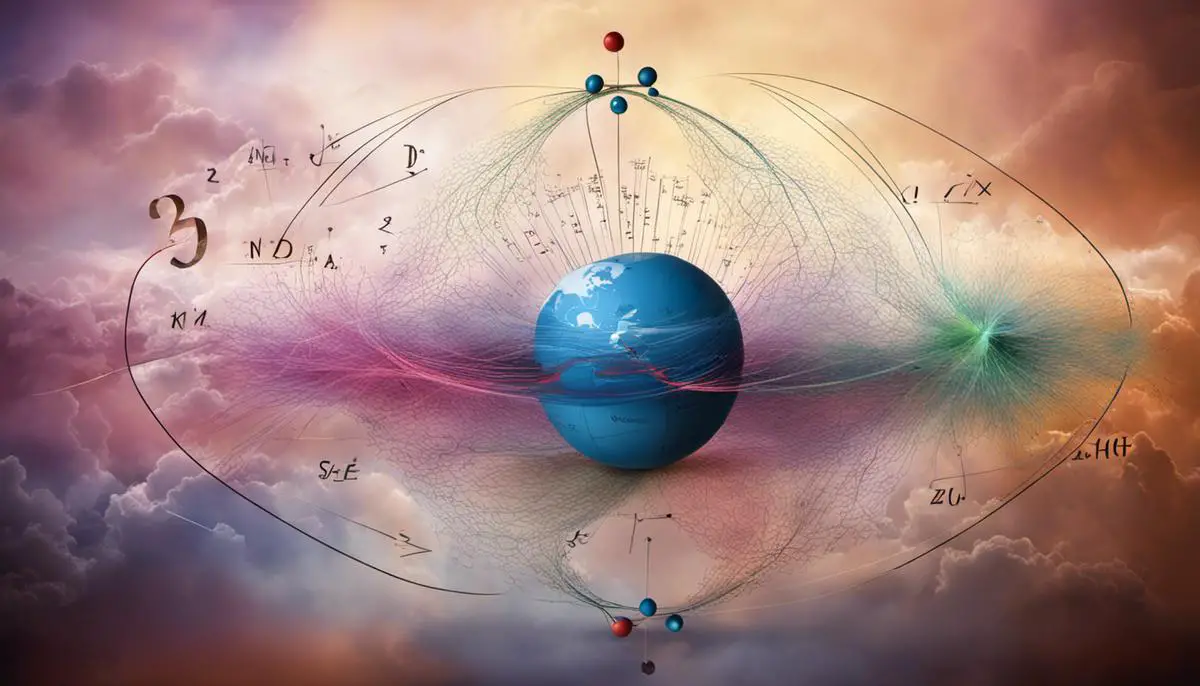The intricate world of mathematics transcends beyond mere numbers and equations – Stable Diffusion Mathematical Concepts. It is an indispensable tool used for modelling and understanding various natural phenomena that occur within our world.
Our exploration focuses on one particular aspect of this mathematical influence — Stable Diffusion. In essence, stable diffusion is a robust model adopted in numerous fields such as physics, finance and data science, to make accurate predictions and drive efficient decision-making processes.
This paper peels back the layers of stable diffusion, beginning with an understanding of the fundamental concept of diffusion itself. Gradually moving through the rich tapestry of stochastic processes, stable distributions, Lévy processes, and mathematical modelling, it settles on practical, real-world applications of stable diffusion.
Contents
The Principle of Stable Diffusion Mathematical Concepts
Understanding Diffusion in Mathematics
Diffusion in mathematical terms refers to a process that spreads the presence of particles in a gas, liquid, or a solid medium, moving from areas of higher concentration to areas of lower concentration. This occurrence can be observed in natural phenomena like smoke spreading in the air, ink droplets moving in water, or heat dispersing in a room. Mathematically, diffusion is modeled using differential equations, primarily partial differential equations (PDEs).
Fick’s Laws of Diffusion
Central to understanding diffusion mathematically are “Fick’s Laws of Diffusion,” named after the scientist Adolf Fick who formulated these principles in 1855. These laws form the basis for many diffusion models.
Fick’s First Law
The first law, often referred to as “Fick’s First Law,” states that the flux (J) of a substance is proportional to the negative gradient of its concentration. If ‘D’ is the diffusivity (a measure of the substance’s capacity to diffuse), the first law can be expressed mathematically as J = -D(grad c), where ‘grad c’ is the concentration gradient.
To elaborate, ‘grad c’ represents the rate at which the concentration changes, and the negative sign in the equation indicates that the substance moves from areas of higher concentration to lower concentration, which forms the essence of diffusion.
Fick’s Second Law
While Fick’s First Law effectively deals with steady-state diffusion, it lacks the capacity to handle changes in concentration over time, leading to what is known as Fick’s Second Law of Diffusion. This law states that the rate of change in concentration (dc/dt) is proportional to the rate of change of the concentration gradient over space. This law can be mathematically expressed as dc/dt = D(d^2c/dx^2), forming the basis of the diffusion equation.
The Math Behind Stable Diffusion
Stable diffusion refers to a state where the concentration of particles being diffused does not change with time. This scenario occurs when the system reaches equilibrium, leading to a balanced state where the rate of particles diffusing in is equal to the rate of particles diffusing out. One common attribute of stable diffusion is a uniform concentration of particles throughout the system.
Mathematically, stable diffusion can be modeled using Fick’s laws as well. In steady-state or stable diffusion, the concentration of the substance does not change over time (dc/dt = 0). Consequently, the diffusion equation simplifies to D(d^2c/dx^2) = 0. This yields a linear concentration profile (dc/dx = constant), which is a characteristic of stable diffusion.
Illustrating Stable Diffusion
Let’s look at a plain example of stable diffusion in action. Visualize a lengthy, slim metal rod. The rod is warmer at one end and cooler at the other. As time progresses, the heat will naturally flow towards the cooler side, gradually creating a uniform temperature throughout the bar. This indicates a stable diffusion state.
Moving to a biological perspective, let’s consider the diffusion of nutrients or gases across the cellular membranes. In this situation, the particles will maneuver across the membrane until an equilibrium is established between the concentrations inside and outside the cell, symbolizing a stable diffusion state.
What’s consistent in both scenarios is that the diffusion process persists until it arrives at a constant state. In this state, there are no alterations in the concentration of the diffusing substance over time or through space.
Introduction to Stochastic Processes
Grasping Stochastic Processes
To comprehend the mechanics of stable diffusion, it’s crucial to understand stochastic processes. These are mathematical models designed to chronicle phenomena wherein a certain level of randomness is introduced at every point in time.
Essentially, they are sequences of random variables, capturing the time-evolving dynamics of a system that incorporates random values. You’ll find their applications in diverse areas of study like physics, chemistry, and economics among others, basically anywhere where unpredictability plays a part.
Brownian Motion and Stable Diffusion
Another significant stochastic process that is highly relevant to stable diffusion is the concept of Brownian motion. Brownian motion describes the random movement of particles suspended in a fluid (such as a gas or liquid) resulting from their collision with the fast-moving molecules in the fluid.
These minute movements are continuous, with particles fluctuating in position due to random impacts. Albert Einstein and Marian Smoluchowski brought significant theoretical explanation to the phenomenon from a bulk fluid dynamics and detailed molecular kinetic theory aspect, resulting in a deeper understanding of the kinetic theory of gases.
This relates to stable diffusion because both Brownian motion and diffusion are processes of the random movement of particles. However, in the context of stable diffusion, specifically, it represents the movement of a substance from an area of higher concentration to one of lower concentration, until the concentration is ultimately the same everywhere. Understanding both of these stochastic processes is vital to grasp the math behind stable diffusion.
Stochastic Processes: Pivotal Elements in Stable Diffusion
In the diverse world of science and finance, stochastic processes play a major role in modeling and predicting the behavior of various uncertain systems. One prime example of this is stable diffusion, which uses these processes to calculate the motion of particles and their rate of spread and distribution.
This knowledge becomes significantly useful in domains such as environmental science. For instance, it assists in forecasting the dispersal of pollutants in air or water, or the transfer of heat in different mediums. In finance, the unpredictability of stock market prices over time can be illuminated through models built on the principles of stable diffusion.
In physics, everything from quantum mechanics to thermodynamics benefits from the theory of stochastic processes. The explanation of Brownian motion, which describes the seemingly random movement of particles in a fluid, and the foundational concepts in studying solid-state diffusion, owe much to this theory.
As recognized from these instances, achieving a comprehensive understanding of the influence of stochastic processes on stable diffusion is absolutely essential. This understanding can empower scholars and researchers in modeling and managing various phenomena influenced by randomness.
Furthermore, an in-depth grasp of these concepts becomes indispensable when it comes to fostering advancements in fields such as stochastic calculus, financial mathematics, statistical physics, and various other disciplines where these concepts are integral.
Stable distributions and Lévy processes
Deciphering Stable Distributions
Alpha-stable distributions, also renowned as Levy-Stable or simply stable distributions, are an integral part of several scientific domains encompassing physics, finance, and even image processing. These distributions owe their popularity to their remarkable statistical properties, one being the Generalized Central Limit Theorem.
While the conventional Central Limit Theorem gives rise to the normal distribution, the Generalized Central Limit Theorem goes a step further. It enables sums of a large number of independent and identically distributed heavy-tailed variables to converge into a stable distribution, distinguishing it from its more common counterpart.
Parameters and Characteristics of Stable Distributions
Essential to understanding stable distributions are the four parameters, namely, the stability parameter alpha (0 0), and the location parameter mu. Alpha defines the heavy-tailed nature: a smaller value corresponds to a heavier tail. The skewness parameter beta promotes asymmetry, with beta equals 0 implying symmetry. The scale parameter sigma determines dispersion, while mu shifts the location of the distribution.
Zolotarev’s Parametrization
Zolotarev’s parametrization of stable distributions is based on the notion of spectral measures. This approach uniquely determines a one-to-one mapping between the four parameters of a stable distribution and its characteristic function. This characterization is a cornerstone for further analytical exploration and application of stable distributions in various fields.
Characteristic Function of Stable Distribution
The characteristic function of a stable distribution has an integral expression derived from the inverse Fourier Transform. This function, representable as an exponential series, is essential for understanding the mathematical structure underlying stable distributions.
Although the explicit form of the Probability Density Function (PDF) is only known for certain values of alpha and beta, the characteristic function always exists and is used to compute necessary statistics such as the expectation and variance when they exist.
Understanding Lévy Processes
A Lévy process is a type of stochastic process characterized by stationary and independent increments. This means the future evolution of the process depends only on its present status and behaves independently of its past. Lévy processes have been widely used in diverse areas of science, including modeling equity prices in finance or describing anomalous diffusion in physics.
A particular facet of these processes is that they may exhibit jumps, a property resulting from their allowance for alpha-stable distributions. The name Lévy processes come from Paul Lévy, who was the first mathematician to study these processes systematically under the framework of probability theory.
Simulating Stable Random Variables
The simulation of stable random variables plays an integral role in gaining a comprehensive understanding of stable distributions and Lévy processes. A well-known and effective approach to accomplishing this is via the Chamber-Mallows-Stuck (CMS) method, an algorithm specifically designed to generate independent, one-dimensional alpha-stable random variables.
These derived stable random variables are instrumental in shaping the simulations for a Lévy process and further advancing statistical studies. In conjunction, the visualization of these simulations can provide tangible and insightful perspectives on the behavior and intrinsic qualities of these distributions, serving as a practical adjunct to the theoretical framework.
Mathematical Modeling of Stable Diffusion
Introduction to Stable Diffusion
Stable diffusion is a pivotal factor in an array of disciplines, spanning from mathematical physics and scientific computing through to various sectors of engineering. This term gives a description to a specific type of random particle motion or dispersion, which is guided and influenced by stochastic variables or a collection of random forces.
The key to comprehending stable diffusion is rooted in the fundamentals of several mathematical structures, primarily probability theory and calculus. Of particular significance are stochastic differential equations (SDEs), which provide the core framework for the modeling and understanding of this concept.
Stochastic Differential Equations and Stable Diffusion
Stochastic differential equations, widely used in mathematical finance, physics, and engineering, are differential equations in which one or more terms have a stochastic, or random, component. They are utilized to model systems that behave unpredictably. In the context of stable diffusion, a stochastic differential equation can be used to model the erratic movement of particles.
An important aspect of SDEs in the context of stable diffusion is their ability to model Lévy processes – a type of stochastic process that generalizes random walk, and characterizes stable diffusion. Lévy processes and the stable distributions associated with them allow for mathematical characteristics of random motion to be precisely described and computed.
A Solution to Stochastic Differential Equations
The solutions to stochastic differential equations, often known as stochastic processes, provide detailed behavior of the system being modeled. Unlike deterministic systems, solutions to SDEs are not single functions. Instead, they are probability distributions, denoting the likelihood of the system’s various states.
These solutions are obtained through an operation called Ito calculus, a branch of mathematical analysis that is used for manipulating stochastic integrals and solving stochastic differential equations. Despite being a complex discipline, understanding Ito calculus is considered fundamental in comprehending the math behind stable diffusion.
Relation to Stable Diffusion
Given the irregular and often unpredictable nature of particle dispersion in stable diffusion, it’s the stochastic differential equations that come handy in predicting the system’s behavior. Through these equations and their solutions, one can measure and predict the random motion of particles, evaluating their positions at different points in time.
The solutions also enable the interpretation of stochastic processes, representing the probability distribution of the diffusion system. This aspect aids in investigating vital properties of stable diffusion, including dispersion, skewness, and kurtosis.
Moreover, using the SDEs and their solutions, specific cases like anomalous diffusion, a form of diffusion that isn’t represented by normal Gaussian statistics, can be further investigated. This fact largely expands the potential applications, contributing to the field’s growing importance in many scientific and engineering disciplines.
Introduction to Stochastic Differential Equations within Stable Diffusion Mathematical Concepts
Stable diffusion, a key concept in the fields of mathematics and physics, is an instrumental model in numerous sectors, contributing to extensive research, sophisticated simulations and innovative technological progressions.
It primarily involves the application of stochastic differential equations. Understanding the mathematical intricacies of stable diffusion is thus crucial, especially for the effects that stochastic differential equations can have in diverse applications.

Analyzing Stable Diffusion in the Real World
Delving Into Stable Diffusion
From a mathematical standpoint, a random process is considered ‘stable’ if its characteristic function, a description of the process’s variance and skewness, follows a stable distribution. This scenario creates what we call a ‘stable stochastic process,’ which applies to phenomena that follow a random walk.
In such a case, the future outcomes are influenced by past results, injected with an element of randomness, resulting in an evolution of the system via a series of often random, incremental changes over time.
On the other hand, the physics behind stable diffusion (also known as ‘normal diffusion’) involves the dispersion of particles from their original position over a period. This physical attribute is a product of the microscopic, random motion of particles, affecting their macroscopic movement. More precisely, stable diffusion connects to the process where the mean square displacement of particles aligns linearly with the time elapsed.
The mathematical basis of Stable Diffusion Mathematical Concepts
Mathematically, stable diffusion gets its fundamental foundation from central limit theorem, Brownian motion, and random walks. It is modelled by the famous diffusion equation, also known as the heat equation. This equation is a vital part of many branches of physics, including statistical mechanics and quantum mechanics.
This difussion equation involves variables like the diffusion coefficient, time, and space. The diffusion coefficient quantifies the speed or intensity of diffusion. This coefficient and the other parameters allow for quantification and exact calculation of the diffusion process over given periods, offering detailed insights into how a system evolves.
Stable Diffusion in Finance
In finance, stable diffusion has been used to create models to predict and assess various financial phenomena. For instance, the Black-Scholes model, widely used in the pricing of options, applies the principles of diffusion. The idea is to gauge how the price of an option diffuses over time, thereby enabling optimal pricing strategies.
The same concept is embodied in Stochastic volatility models as well. These are used to model how financial market volatility evolves over time following a random process. The underlying security’s price variance follows a random walk, exhibiting an element of diffusion.
Stable Diffusion in Data Science
The field of data science has also borrowed these principles. Stable diffusion has proven particularly useful in areas that involve stochastic processes and time-series modelling. In theory, many forms of data, such as daily temperatures or stock market returns, could be modelled as stable processes.
For instance, predicting future data values from past ones is a common practice in time series analysis and forecasting. This process could involve predicting future stock prices based on past performance, assuming the return-to-risk ratio remains fairly stable over time.
In the field of machine learning, Markov Decision Processes represent a probabilistic model, which inherently applies principles of diffusion for modelling decision-making situations.
In conclusion
Understanding the mathematical basis of stable diffusion not only fortifies comprehension of several real-world phenomena but also provides a valuable tool for researchers and practitioners in diverse fields. Moreover, the application of stable diffusion improves decision-making strategies and optimizes predictive analyses.
Through the journey into the depths of Stable Diffusion Mathematical Concepts, we come to appreciate the substantial roles played by Fick’s laws, Markov chains, Brownian motion, zolotarev’s parametrization and stochastic differential equations. With this profound knowledge, it is clear that the mathematics intricately entwined with stable diffusion offers impeccable preciseness and accuracy in modeling.
The broad spectrum of its applications vary across several fields; physics, data science and the financial sector, where its contributions have proven to be of valuable support. This exploration not only enhances our comprehension of stable diffusion, but also arouses our curiosity to extend our knowledge, challenge existing models and strive to develop newer, more efficient ones.

Emad Morpheus is a tech enthusiast with a unique flair for AI and art. Backed by a Computer Science background, he dove into the captivating world of AI-driven image generation five years ago. Since then, he has been honing his skills and sharing his insights on AI art creation through his blog posts. Outside his tech-art sphere, Emad enjoys photography, hiking, and piano.
